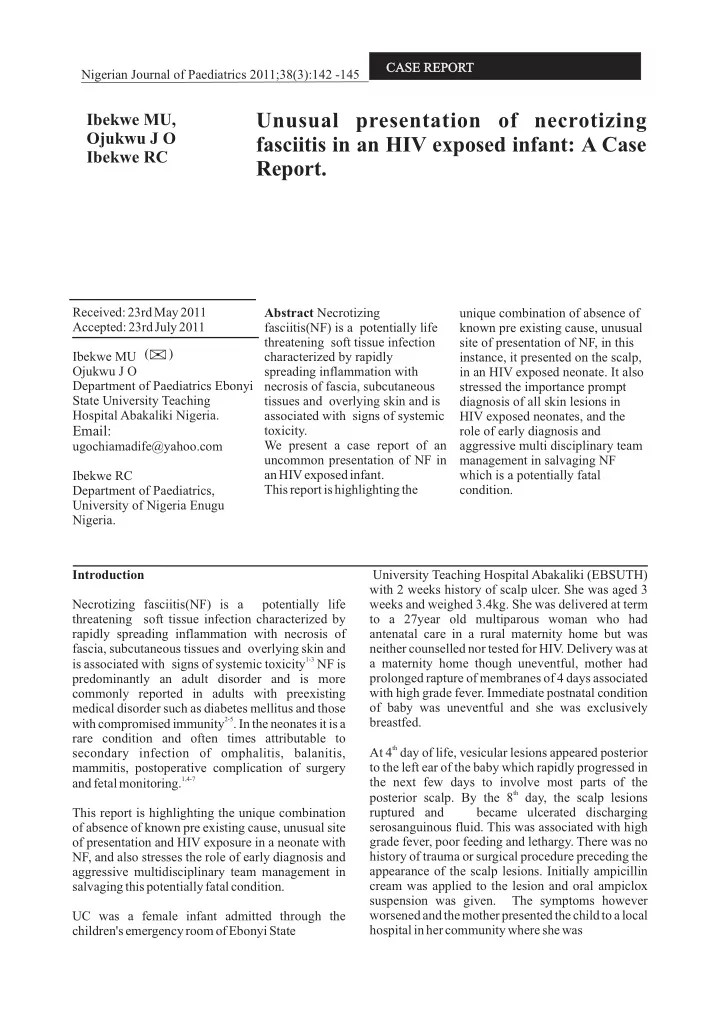

CASE�REPORT Nigerian�Journal�of�Paediatrics�2011;38(3):142�-145 Ibekwe�MU, Unusual presentation of necrotizing Ojukwu�J�O fasciitis in an HIV exposed infant: A Case Ibekwe�RC Report. Received:23rd May 2011 Abstract Necrotizing unique�combination�of�absence�of Accepted:23rd July 2011 fasciitis(NF)�is�a��potentially�life known�pre�existing�cause,�unusual threatening��soft�tissue�infection site�of�presentation�of�NF,�in�this (������) Ibekwe�MU characterized�by�rapidly instance,�it�presented�on�the�scalp, Ojukwu�J�O spreading�inflammation�with in�an�HIV exposed�neonate.�It�also Department�of�Paediatrics�Ebonyi necrosis�of�fascia,�subcutaneous stressed�the�importance�prompt State�University Teaching tissues�and��overlying�skin�and�is diagnosis�of�all�skin�lesions�in Hospital Abakaliki�Nigeria. associated�with��signs�of�systemic HIV exposed�neonates,�and�the Email: toxicity. role�of�early�diagnosis�and We present a case report of an ugochiamadife@yahoo.com aggressive�multi�disciplinary�team uncommon presentation of NF in management�in�salvaging�NF Ibekwe�RC anHIVexposedinfant. which�is�a�potentially�fatal Thisreportishighlightingthe condition. Department�of�Paediatrics, University�of�Nigeria�Enugu Nigeria. University Teaching Hospital Abakaliki (EBSUTH) Introduction with 2 weeks history of scalp ulcer. She was aged 3 Necrotizing fasciitis(NF) is a potentially life weeks and weighed 3.4kg. She was delivered at term threatening soft tissue infection characterized by to a 27year old multiparous woman who had rapidly spreading inflammation with necrosis of antenatal care in a rural maternity home but was fascia, subcutaneous tissues and overlying skin and neither counselled nor tested for HIV. Delivery was at 1-3 a maternity home though uneventful, mother had is associated with signs of systemic toxicity NF is predominantly an adult disorder and is more prolonged rapture of membranes of 4 days associated commonly reported in adults with preexisting with high grade fever. Immediate postnatal condition of baby was uneventful and she was exclusively medical disorder such as diabetes mellitus and those 2-5 breastfed. with compromised immunity . In the neonates it is a rare condition and often times attributable to th At 4 day of life, vesicular lesions appeared posterior secondary infection of omphalitis, balanitis, to the left ear of the baby which rapidly progressed in mammitis, postoperative complication of surgery 1,4-7 the next few days to involve most parts of the andfetalmonitoring. th posterior scalp. By the 8 day, the scalp lesions This report is highlighting the unique combination ruptured and became ulcerated discharging of absence of known pre existing cause, unusual site serosanguinous fluid. This was associated with high of presentation and HIV exposure in a neonate with grade fever, poor feeding and lethargy. There was no history of trauma or surgical procedure preceding the NF, and also stresses the role of early diagnosis and appearance of the scalp lesions. Initially ampicillin aggressive multidisciplinary team management in cream was applied to the lesion and oral ampiclox salvagingthispotentiallyfatalcondition. suspension was given. The symptoms however UC was a female infant admitted through the worsened andthemotherpresentedthechildtoalocal hospitalinhercommunitywhereshe was children's emergencyroomof EbonyiState
143 th managed as a case of cellulitis. By the 15 day of Cefotaxime and augumentin. Swab culture from the scalp lesion yielded (a) B-Haemolytic Streptococcus onset of the lesion, the baby's condition deteriorated that was sensitive to ciprofloxacin, septrin, and and she was referred to EBSUTH for expert augumentin but resistant toAmpiclox, erythromycin, management. ceftriaxone, and gentamicin. (b) Klebsiella spp that On admission she was acutely ill looking but was sensitive to ciprofloxacin,ceftriaxone,oflaxacin conscious, febrile, with a maximum axillary a n d c e f a t o x i m e b u t r e s i s t a n t t o o augumentin,gentamycinandseptrin. temperature of 38.9�C. She appeared mildly pale but Human immunodeficiency virus (HIV) test was not dehydrated. She had a heart rate of140 beats/min positive for the mother; however the baby's HIV and respiratory rate of 80 breaths/min. There was an status could not be confirmed due to lack of facility extensive ulcer over the posterior half of the scalp forPCR inourcenter. and neck (fig 1, 2) which extended over the parietal and occipital areas of the scalp and posterior aspects Within 24 hours of presentation, the surgical team of theneck. was invited and subsequently the baby was taken to the theatre for wound debridement. All the non viable tissues were debrided until wound edges bled freely. The wound was later covered with sufra-tule anddressed onadailybasis The antibiotics were later changed accordingly to ciprofloxacin, and baby responded favourably after a 3 weeks course on antibiotics. By the 2nd week following admission granulation tissue was noticed, however this did not completely cover the exposed occipital bone. Plans were made for wound resurfacing by the plastic surgeons, but this was Figure 1 however not done because the family could not bear the financial burden of plastic surgery. The child was discharged home after 31 days of hospital stay and was commenced on cotrimoxazole for pneumocystic carini pneumonia (PCP) prophylaxis. She was subsequently lost to follow up and plastic surgery couldnotbedone. Discussion Neonatal fasciitis (NF) is an uncommon but often fatal bacterial infection of the skin, subcutaneous Figure 2 1,4-7 8,9 tissue and fascia. However Legbo in his experience with 32 cases of childhood NF, reported There was destruction of skin, subcutaneous fascia that NF may not be uncommon among neonates in and muscle tissues leading to complete loss of posterior scalp exposing the occipital bone with North western Nigeria and is associated with purulent exudation (fig1, 2). The total body surface significant mortality and morbidity. Most studies report that NF is usually initiated following area involved was estimated at 9.5%. The full blood omphalitis, mammitis, balanitis fetalscalp count revealed a packed cell volume of 30% (37- 9 9 monitoring, necrotising enterocolitis, 49%), a white cell count of 24.1x10�/l (4-11x10�/l).A 4,5,10 Immunodeficiency and bullous impetigo . It rarely peripheral blood film revealed a shift to the left with 4,5 toxic granulations of neutrophils. A diagnosis of NF starts de novo. This index case contrasts these with overwhelming neonatal sepsis was made and reports as the child was in apparent good health at the baby was commenced empirically on ceftriaxone birth with no obvious predisposing factor following andgentamycin. the appearance of the scalp lesion While it is possible 5 that this case might be due to primary NF (which 5 Blood Culture yielded Staphylococcus aureus that impliesabsenceof anyknown cause)whichisrare. was sensitive to ciprofloxacin, ceftriaxone and gentamycinbutresistanttoseptrin, ampiclox, It is also possible that seemingly insignificant trauma
Recommend
More recommend